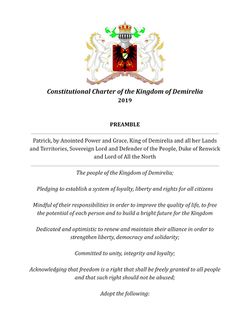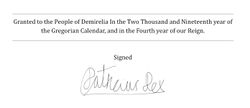Constitutional Charter of Demirelia
| Constitutional Charter of the Kingdom of Demirelia | |
 Front page of the Constitutional Charter of 2019
| |
| Created | October 5, 2019 - October 10, 2019 |
| Ratified | 10 October 2019 |
| Authors | Patrick Renwick |
| Signers | Patrick I, King of Demirelia |
The Constitutional Charter of the Kingdom of Demirelia (Norwegian: Det Konstitusjonelle Frihetsbrev for Kongeriket Demirelia) is the fundamental law of the Kingdom of Demirelia. It was adopted on 10 October 2019, as the first constitution of the Kingdom, enacted by King Patrick.
The constitution laid out the structure of the government and divided it into three, namely the King-in-Council, the King-in-Parliament and the King-on-Bench, and made the duties, functions and powers of each branch clear and concise compared to the previous loose assembly of royal decrees, laws and precedents. It also clearly dictated the rights of the citizens.
The Constitution has two versions, one written in Norwegian and one in English. As per a declaration made by the Landsting at the time of ratification of the Charter on 10 October 2019, the Norwegian language version of the Charter is authoritative and takes precedence over the English. The Norwegian version is composed of around 2500 words in total, whereas the English is composed of about 3000 words.
Name
The name Constitutional Charter was specifically chosen for the document as opposed to simply Constitution to signify the documents origin; as a gift from the king granted to the people, as opposed to having been written and enacted by the people themselves.
History
Constitutional draft of 2018
The draft Constitution of 2018 was the first attempt at a constitutional document made in Demirelia. The process was initiated by the Daniels administration shortly after Edward Daniels’ appointment to the Statskanslership in April 2018. The draft was primarily written by Statskansler Daniels and was heavily inspired by the United States constitution. The draft, though giving significant powers to the Monarchy, such as being able to veto legislation and dissolve the Landsting, officially vested all executive power with the Statskansler and sovereignty with the people. Work on the draft was however greatly hampered by increasing inactivity within Demirelia at the time, and the draft was finally abandoned in August of that year.
Constitutional Charter of 2019

Following the return to micronationalism of King Patrick I in early October 2019 after a year of absence, the idea of a written constitution was brought back. The process of drafting the new document was started on 5 October. Major inspiration was taken from the 2018 draft constitution, with many of its articles being incorporated in the new Charter, though some with significant changes. Other inspirations included the Abeldane Constitution, the Constitution of Norway and the French Charter of 1814.
The new Constitutional Charter was significantly more conservative than the 2018 draft, vesting the Monarchy with far more powers and privileges, including official executive power, sovereignty, and legal immunity. By 7 October the decision to create an official Norwegian version of the Charter was taken, and the English version was duly translated.
On 10 October, following final adjustments and additions, the Constitutional Charter was presented by the king before the first meeting of the Landsting in over a year. Here, it was unanimously adopted and immediately signed by the king. Following this, the Landsting made a unanimous declaration, declaring the Norwegian version of the Charter to have precedence and supremacy over the English version in any potential conflicts.
Contents
Preamble
The people of the Kingdom of Demirelia;—
Pledging to establish a system of loyalty, liberty and rights for all citizens
Mindful of their responsibilities in order to improve the quality of life, to free the potential of each person and to build a bright future for the Kingdom
Dedicated and optimistic to renew and maintain their alliance in order to strengthen liberty, democracy and solidarity;
Committed to unity, integrity and loyalty;
Acknowledging that freedom is a right that shall be freely granted to all people and that such right should not be abused;
Adopt the following:—
A. THE FORM OF GOVERNMENT

Title A. of the Charter outlines the form of government of the Demirelian state. It encompasses Article 1 and declares the Kingdom to be “one realm, indivisible and inalienable in perpetuity“, and the form of government to be a limited, hereditary monarchy.
B. THE EXECUTIVE POWER, THE MONARCH, SUCCESSION AND THE ROYAL FAMILY
Title B. encompasses articles 2 through 15 and outlines the powers of the monarchy, royal titles and the line of succession.
C. THE LEGISLATIVE
Title C. describes the powers, composition and election of the Demirelian legislature, the Landsting. It also lays out the way in which a bill is given royal assent. Title C. Comprises articles 16 through 24.
D. THE JUDICIAL POWER
Title D. describes the role, powers and duties of the Judiciary of Demirelia and the appointment of judges. It constitutes articles 25 through 28.
E. THE RIGHTS OF MAN AND THE CITIZEN
Title E. lays out human rights and the rights of the citizens within Demirelia. Amongst other things it guarantees life, property, freedom of speech and expression, freedom of religion, and the abolition of slavery. It comprises articles 29 through 43.
F. GENERAL PROVISIONS
Title F. constitutes the general provisions of the state, such as the official name, flag, coat of arms, motto, and the capital. It consists of articles 44 through 53.
G. AMENDMENT
Title G. establishes the process of amendment of the Constitutional Charter. It establishes that a 2/3 majority of the Landsting is required to approve constitutional changes during 3 consecutive sessions, and that such changes must receive royal assent. It consists of the last article of the Charter, Article 54.
See also
External links
- Constitutional Charter of the Kingdom of Demirelia (2019) (English)
- Constitutional Charter of the Kingdom of Demirelia (2019) (Norwegian)
- Draft Constitution of the Kingdom of Demirelia (2018) (English)